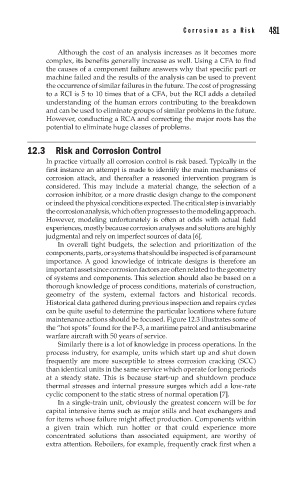Page 514 - Corrosion Engineering Principles and Practice
P. 514
480 C h a p t e r 1 2 C o r r o s i o n a s a R i s k 481
Although the cost of an analysis increases as it becomes more
complex, its benefits generally increase as well. Using a CFA to find
the causes of a component failure answers why that specific part or
machine failed and the results of the analysis can be used to prevent
the occurrence of similar failures in the future. The cost of progressing
to a RCI is 5 to 10 times that of a CFA, but the RCI adds a detailed
understanding of the human errors contributing to the breakdown
and can be used to eliminate groups of similar problems in the future.
However, conducting a RCA and correcting the major roots has the
potential to eliminate huge classes of problems.
12.3 Risk and Corrosion Control
In practice virtually all corrosion control is risk based. Typically in the
first instance an attempt is made to identify the main mechanisms of
corrosion attack, and thereafter a reasoned intervention program is
considered. This may include a material change, the selection of a
corrosion inhibitor, or a more drastic design change to the component
or indeed the physical conditions expected. The critical step is invariably
the corrosion analysis, which often progresses to the modeling approach.
However, modeling unfortunately is often at odds with actual field
experiences, mostly because corrosion analyses and solutions are highly
judgmental and rely on imperfect sources of data [6].
In overall tight budgets, the selection and prioritization of the
components, parts, or systems that should be inspected is of paramount
importance. A good knowledge of intricate designs is therefore an
important asset since corrosion factors are often related to the geometry
of systems and components. This selection should also be based on a
thorough knowledge of process conditions, materials of construction,
geometry of the system, external factors and historical records.
Historical data gathered during previous inspection and repairs cycles
can be quite useful to determine the particular locations where future
maintenance actions should be focused. Figure 12.3 illustrates some of
the “hot spots” found for the P-3, a maritime patrol and antisubmarine
warfare aircraft with 50 years of service.
Similarly there is a lot of knowledge in process operations. In the
process industry, for example, units which start up and shut down
frequently are more susceptible to stress corrosion cracking (SCC)
than identical units in the same service which operate for long periods
at a steady state. This is because start-up and shutdown produce
thermal stresses and internal pressure surges which add a low-rate
cyclic component to the static stress of normal operation [7].
In a single-train unit, obviously the greatest concern will be for
capital intensive items such as major stills and heat exchangers and
for items whose failure might affect production. Components within
a given train which run hotter or that could experience more
concentrated solutions than associated equipment, are worthy of
extra attention. Reboilers, for example, frequently crack first when a

